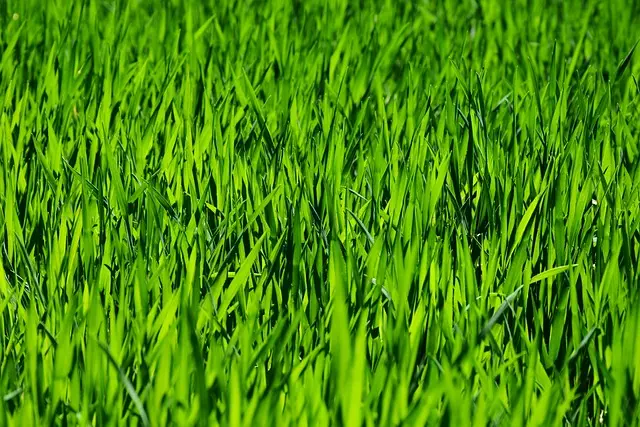Lawn Care and Landscaping are crucial for enhancing a property's curb appeal, with consistent fertilization being a key practice to support healthy grass growth, improve soil quality, and help the turf withstand environmental challenges. A balanced N-P-K fertilizer ratio (such as 20-5-10) is essential for providing nitrogen for foliar development, phosphorus for root growth, and potassium for overall resilience. Additionally, regular soil testing tailors fertilization to specific needs, while incorporating both pre-emergent and post-emergent herbicides helps maintain a dense turf that naturally inhibits weed growth. A year-round fertilization schedule with seasonal adjustments for cool or warm-season grasses is recommended, along with strategic timing for applications to ensure optimal lawn health. Organic or synthetic fertilizers can both be used effectively in Lawn Care and Landscaping, with decisions based on personal preference, environmental impact, and specific lawn requirements. Lastly, effective weed management through timely pre-emergent and post-emergent herbicide applications is a vital component of maintaining a lush, green, and visually appealing lawn.
Maintaining a lush, resilient lawn is a pursuit that blends science with art, requiring an understanding of nutrient needs, timing, and the delicate balance between nurturing desirable grass and managing unwanted weeds. This article delves into the nuances of lawn fertilization and weed control, offering insights and practical advice to ensure your turf thrives. From decoding the essential nutrients in fertilizers to mastering the art of timing applications for peak effectiveness, we explore various strategies and techniques. Discover how organic versus synthetic options can impact your lawn’s health, and learn about the critical role of soil pH in optimizing fertilization outcomes. Additionally, we’ll cover weed control methods, from pre-emergent and post-emergent treatments to identifying common invasive species and their eradication techniques.
As you navigate through the intricacies of lawn care and landscaping, this guide will also address environmental considerations and sustainable practices, ensuring your efforts contribute positively to ecological balance. From aeration to overseeding for a dense, vibrant turf, and understanding the importance of watering, we’ll provide seasonal maintenance tips tailored for year-round lawn care excellence. For those pondering over professional assistance, we’ll help you determine when it’s best to enlist expert services. Ultimately, this article aims to transform your approach to lawn care and landscaping, leading to a successful, enviable transformation of your outdoor space.
- Understanding Lawn Fertilization: The Basics and Benefits for Healthy Turf
- Key Nutrients in Lawn Fertilizers: What's Inside Your Bag of Fertilizer
- Timing Your Fertilization: When to Apply Fertilizer for Optimal Results
- Organic vs. Synthetic Fertilizers: Making the Right Choice for Your Lawn
- Weed Control Strategies: Pre-Emergent and Post-Emergent Treatments
Understanding Lawn Fertilization: The Basics and Benefits for Healthy Turf

A well-maintained lawn adds significant curb appeal to any property, and a cornerstone of effective lawn care is fertilization. This practice involves applying nutrients to your turf to promote healthy growth, improve soil quality, and ensure that your grass can withstand environmental stressors. The primary goal of lawn fertilization is to replace the nutrients that natural processes deplete from the soil over time. Nitrogen, phosphorus, and potassium are essential macronutrients that support foliar development, root growth, and overall turf resilience. By understanding the type of grass you have and its specific needs, you can tailor your fertilization program to deliver these nutrients at optimal times throughout the growing season—typically in early spring, mid-spring, late summer, and fall for cool-season grasses, or early spring and late spring for warm-season varieties.
In addition to providing a balanced diet for your lawn, fertilization also plays a crucial role in weed control. A healthy, dense turf naturally chokes out weeds by shading the soil surface, making it difficult for unwanted plants to establish themselves. Lawn care and landscaping professionals often use a combination of pre-emergent and post-emergent herbicides as part of a comprehensive fertilization program. Pre-emergent treatments prevent weed seeds from germinating, while post-emergent treatments target existing weeds. By integrating these strategies, homeowners and landscaping services can maintain a lush, green lawn that is less susceptible to invasive species, thereby enhancing the aesthetic appeal and functionality of outdoor spaces. Regular fertilization and targeted weed control are integral to achieving a vibrant, healthy lawn that stands as a testament to meticulous lawn care and landscaping efforts.
Key Nutrients in Lawn Fertilizers: What's Inside Your Bag of Fertilizer

Lawn Care and Landscaping practices often revolve around maintaining a lush, vibrant turf, which is where understanding the key nutrients in lawn fertilizers becomes crucial. A well-balanced bag of fertilizer typically contains a blend of three primary macronutrients essential for grass growth: nitrogen (N), phosphorus (P), and potassium (K). These are represented numerically on the fertilizer label, often as an N-P-K ratio such as 20-5-10. Nitrogen promotes leaf growth, ensuring a dense and lush turf; phosphorus contributes to root development, which is vital for a strong and resilient lawn; and potassium aids in overall plant health and stress resistance. Additionally, secondary and micronutrients like calcium, magnesium, sulfur, iron, manganese, and zinc are also vital for a healthy lawn. These play roles in enzyme activation, disease resistance, and chlorophyll production, which is pivotal for photosynthesis. Lawn Care and Landscaping professionals often recommend regular soil testing to determine the specific nutrient needs of your lawn, allowing for precise adjustments to fertilizer applications throughout the growing season to ensure a robust and resilient landscape.
Timing Your Fertilization: When to Apply Fertilizer for Optimal Results

Lawn Care and Landscaping professionals often emphasize the importance of timing your fertilization for optimal lawn health. The application of fertilizer is a critical component in maintaining a lush, green lawn, and understanding the right time to apply it can significantly enhance grass growth and resilience. Typically, early spring is an ideal period to initiate fertilization as it provides nutrients that help your lawn recover from winter’s dormancy and prepare for the active growing season ahead. A balanced N-P-K (nitrogen-phosphorus-potassium) fertilizer, rich in nitrogen, is beneficial at this time to promote leaf growth.
As the season progresses, adjust your lawn care routine accordingly. During the summer months, when grass growth slows due to higher temperatures and less rainfall, a slower-release fertilizer can ensure a steady supply of nutrients without encouraging excessive growth that could stress the lawn. Fall is another crucial window for fertilization, as applying a high-phosphorus fertilizer encourages root growth, setting your lawn up for a robust winter and a strong come back in the spring. Adhering to these timelines within your broader Lawn Care and Landscaping regimen can lead to a healthier, more vibrant lawn throughout the year.
Organic vs. Synthetic Fertilizers: Making the Right Choice for Your Lawn

When considering lawn care and landscaping practices, selecting between organic and synthetic fertilizers is a pivotal decision for maintaining a healthy and vibrant lawn. Organic fertilizers, sourced from natural materials like compost, manure, and bone meal, offer a slow-release nutrient supply that can enhance soil health over time. They support beneficial microorganisms and improve soil structure, which in turn can lead to a more resilient turf. Moreover, organic options are often safer for the environment, as they reduce the risk of nutrient runoff into waterways.
On the other hand, synthetic fertilizers, composed of chemicals like nitrogen, phosphorus, and potassium, provide a quick fix for lawn deficiencies. Their rapid-acting properties can lead to a lush green lawn faster than organic alternatives. However, this convenience comes with considerations regarding their environmental impact and potential for promoting weed growth. The choice between organic and synthetic fertilizers should be made after evaluating factors such as the specific needs of your lawn, local environmental conditions, and personal preferences regarding the frequency of application and the long-term benefits to soil health. Implementing a well-thought-out lawn care and landscaping regimen that incorporates either organic or synthetic fertilizers can contribute to a beautiful and sustainable landscape.
Weed Control Strategies: Pre-Emergent and Post-Emergent Treatments

Engaging in effective lawn care and landscaping requires a strategic approach to weed control, which includes both pre-emergents and post-emergent treatments. Pre-emergent herbicides are applied before weeds germinate, creating a barrier that prevents them from establishing roots in the soil. These treatments are crucial for maintaining a lush lawn as they protect against a wide range of broadleaf weeds and grassy weeds, ensuring that your lawn remains unmarred by intrusive growths. When selecting pre-emergent herbicides, it’s important to consider the specific weed species present in your area and the timing of their application for optimal effectiveness.
In contrast, post-emergent treatments are administered after weeds have already surfaced. These treatments are designed to target existing weeds, effectively killing them without harming the desirable turf grass. Post-emergent herbicides can be selective or non-selective, depending on the desired outcome and the weed spectrum. A careful application of these products by professionals in lawn care and landscaping ensures that only the unwanted vegetation is affected, maintaining the health and aesthetics of your lawn. Regular monitoring and timely applications are key to the successful management of weeds in any lawn care program.
lawn care and landscaping play a pivotal role in maintaining a verdant and thriving turf. This article has delved into the nuances of lawn fertilization, shedding light on the essential nutrients that support grass health and the strategic timing for application to maximize benefits. The decision between organic and synthetic fertilizers was also examined, offering readers a clearer understanding of how each option can impact their lawn’s vitality. Weed control, another critical aspect, was explored with a focus on both pre-emergents and post-emergents, ensuring that readers are well-equipped to manage weeds effectively. By integrating these practices into a comprehensive lawn care routine, homeowners can achieve a lush, green landscape that stands as a testament to their commitment to landscaping excellence.


